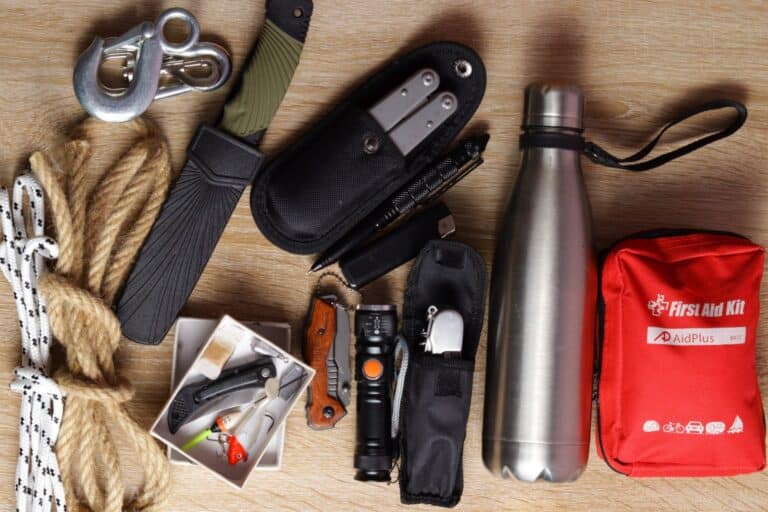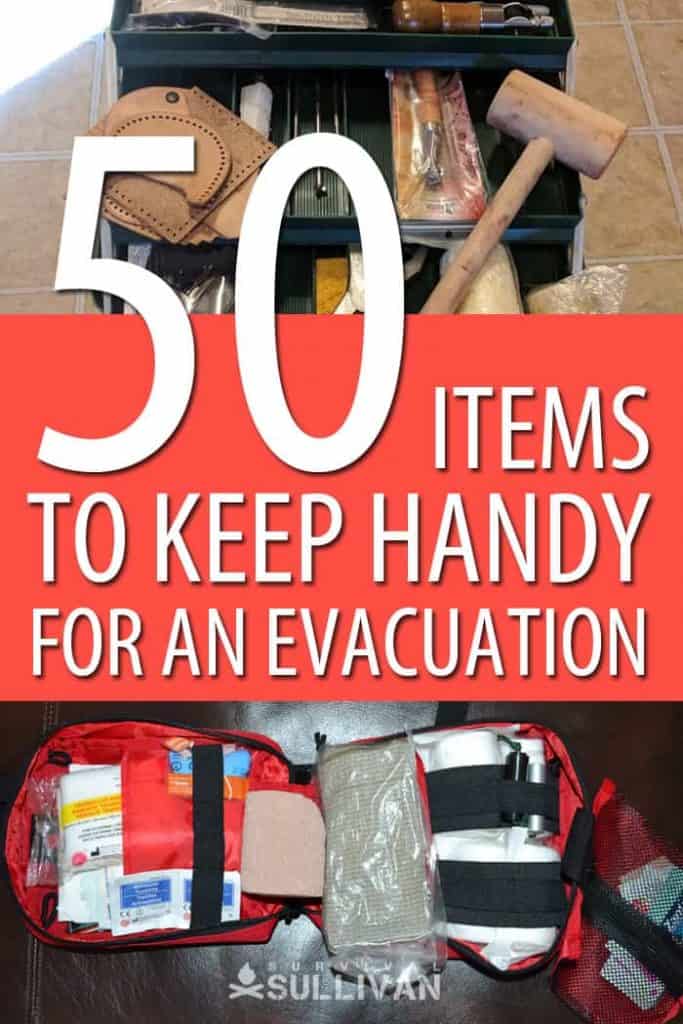Your bug out bag can’t hold everything you may want to take with you in an evacuation. It is filled with only the items you need for survival to get you and your family through at least 3 days, possibly a week.

But do you know what other items you should have handy for an evacuation, in addition to your BOB?
Your BOB is ready to grab at a moment’s notice so you can get out of the house quickly in the event to of some unforeseen trouble. If you’re thoroughly prepared, each family member has their own bug out bag prepared and ready.
But what if you have a little bit of warning ahead of time that something is coming? What if you have advance notice, let’s say an hour or so tops, that a natural disaster or some other event is happening that makes your home and entire area completely unsafe for you to bug-in?
And maybe the advance notice also warns you of the possibility you won’t be returning home for quite some time, if at all. When an evacuation call is made in advance, even if you decide to wait it out for a short period of time, you should immediately begin packing your bug out vehicle as if you are evacuating.
Pretend you are going camping and will be in a tent for a week to 10 days or maybe longer.
Provided you have space in your bug out vehicle, here are some additional items, besides your bug out bag, to keep handy and ready to load in case of an evacuation.
You won’t be able to take ALL of this stuff, obviously, as you will be limited by space in your BOV but these are suggestions for you to think about:
Table of Contents
Shelter and Warmth
Disclosure: This post has links to 3rd party websites, so I may get a commission if you buy through those links. Survival Sullivan is a participant in the Amazon Services LLC Associates Program. As an Amazon Associate, I earn from qualifying purchases. See my full disclosure for more.
- Multiple plastic rain ponchos (disposable) or a more expensive high-quality rain coat for each person is a must.
- A complete high-quality tent like the Alps Mountaineering Chaos 2 or Standsport “Scout” Backpack Tent that you have already practiced putting together numerous times.
- Rainfly or extra tarps.
Food and Water
- Extra Jugs of Properly Stored Water
- Dry Goods and staple foods (salt, sugar, baking soda, flour, beans, rice, pasta, etc.)
Tip: Pack these in 5-gallon plastic buckets using Mylar bags. Put 1 bag of each food in EACH bucket so your buckets have 1 bag of rice, 1 bag of pasta, 1 bag of beans, etc. A second bucket with 1 bag of salt, 1 bag of sugar, 1 bag of flour, etc.
- Canned Goods (tuna fish, chicken breast, beans, soups, spam, potatoes, etc.)
- Portable Cookstove (with several extra propane tanks)
- Several cases of baby formula/baby food if applicable
- Extra fishing poles (the non-folding ones that don’t fit in your pack)
- Bow & arrows or other hunting gear
- Any pots, pans, utensils, etc that you have room for
Extra Tip: Add ¼ teaspoon of salt and ¼ tsp of baking soda to 2 tablespoons of sugar and mix with a quart of water. This creates an electrolyte replacement beverage that can help your family if dehydration sets in.
Health and Sanitation
- Several Jugs of Bleach (make sure you rotate it often as its shelf life is pretty short)
- Hiking Boots for everyone
- Boxes of Rubber Gloves
- Cases of Toilet Paper and Paper Towels
- Several Large Boxes of Baby Wipes
- Extra cases of diapers if applicable
- Boxes of Personal Female Hygiene Items
- Additional First Aid Things like rolls of gauze, bandages, blood pressure cuff, etc.
The best way to store these items is to create a Health and Sanitation bin out of a Rubbermaid tub. Make sure each Health and Sanitation bin includes some of each item so that if you could only take 1 of these tubs you would have some of everything you need.
Tools
- Shovel
- Rake
- Hand saws and other hand tools
- Chainsaw with extra gas, oil, chain
- Ax and/or Machete
- Fire Hydrant Wrench (if SHTH then this may be your only source for water)
- Large Channel Lock Pliers with Angled Head (for turning water main on and off)
- Water Meter Key
Transportation
- Replacement Water Hoses
- Extra brake line for repairs
- Hoses for car repairs
- Fuses for car repairs
- Extra Cans of fuel for vehicle
- Inflatable Raft or Boat (if river or another waterway is a backup bug out route)
- Wagon
- Stroller
Make sure your car bug out bag is kept well-stocked. But if your BOV were to break down and you cannot make the repairs or if roads are blocked and you cannot get your vehicle forward, you will need a backup transportation plan.
Alternate transportation could be adding a bike rack and bikes on the back of your car, it could be collapsible bicycles or scooters stored in your trunk, it could even be a skateboard, a golf cart, or a four-wheeler.
Just make sure whatever your alternate transportation is, you plan for how you might transport additional supplies too if possible.
Consider something like the InStep Take 2 Double Bicycle Trailer or the Schwinn Double Bicycle Trailer to carry your children or even extra supplies. Most of them are designed to carry up to 80 pounds.
The Schwinn is nice if your budget allows because if folds up quickly for easy storage and it can be used as a jogging stroller or a bike trailer which provides, even more, flexibility for bugging out.
Safety and Security
- Additional Firearms (these would be any additional guns not carried in your EDC, GHB, or BOB.
- Extra Ammunition (in addition to ammo in your GHB and BOB)
- Non-Lethal Self Defense weapons
- Knives (in addition to those in your EDC, GHB, and BOB)
- Ham Radio Equipment
Gardening Items
One of the more recent things that has come to light for many preppers is the idea of making your garden portable at least in some respects. Many people do this using plastic trays or pots, hanging baskets, or 5 gallon buckets. I’ve even see people use over the door type canvas shoe organizers on an old piece of wooden door to grow plants in!
There are many things including herbs, like basil, oregano, thyme, etc. that can be grown in small plastic trays, pots, or the shoe organizer. You can also grow a number of different plants for medicinal purposes in small pots or 5-gallon buckets.
Vegetables, like cucumbers, melons, peppers, bush beans, eggplant, squash, and many more will grow okay in buckets. So start your portable garden now and when you bug out, make sure you load those 5 gallon buckets into the car or truck along with everything else.
Other Items
- Portable Generator
- A Rubbermaid plastic tub packed with 1 or 2 sets of additional Warm/Seasonal clothing
- Winter weather clothing accessories (hats, gloves, scarves) for each family member.
- Extra Blankets and Pillows
- Fireproof or waterproof safe with important documents
- Pet Food and Transport Cage
- Portable Fans or Heaters to run from generator
- Bath Towels
- Cases of Personal Hygiene Items (toothpaste, shampoo, soaps, etc.)
Pack comfort items so that each container of comfort items has some of everything you would need. If you have two or three tubs in this category and only have time to grab one, make sure it would suffice.
Packing Tips
Each food container should have dry goods, some canned goods, some dried meat, etc. If you run out of time or have to abandon your vehicle and can only take one food container, you still have the right foods to prepare some meals without taking the time to re-pack it all.
Although it seems more logical, do NOT pack 1 Rubbermaid plastic tub for each person but instead, pack multiple tubs with 2 sets of clothes (warm/cold climate) for each family member. This way if you run out of space and can’t take all of your Rubbermaid tubs, nobody gets left without clothes.
Make sure all plastic tubs, bags, or containers are clearly identifiable so you know with one glance what is contained inside. This will make things a lot easier and less stressful during evacuation and beyond. There’s nothing worse than thinking you grabbed 2 tubs of food and finding out both were packed with clothes.
Color coding of containers or use of bright, colored blocks of duct tape can help you easily distinguish which containers should take priority over others. Use color coding that makes sense to your group and practice packing several times so you can do it automatically under pressure.
Some preppers color code by priority for example Green=always pack if room, Yellow=pack if all green have been packed, Red=extra/luxury items only pack extra ones only if all extra green and yellow have been packed.
Others pack by category for example Black=Security/Safety items, Green=Shelter/Warmth, Yellow=Food/Water, etc. Do what is most logical for your group.
Store your containers in a way so that when you begin packing your bug out vehicle you put in one container of food, one container of clothes, one container of repair items, etc. This way when you run out of space, you will know that you have at least some of each type of item already packed.
Whenever you have extra space in BOV and still have time before evacuating, add extra warmth, water, or food items in that order. Without the ability to stay warm and protected from the extreme weather elements, you can freeze to death in a matter of hours.
If that happens, the extra water or food is useless. Water is the second most crucial thing to pack extra of if you can because an adult can survive up to 3 weeks or longer without food if need be.
If you have packed your BOB well and keep your BOV stocked and well-maintained you are off to a great start and will have what you need to survive.
The more supplies you have with you and the better prepared you are, the more likely it is that you and your family will not just survive but you will thrive in a post-evacuation situation.


Born and raised in NE Ohio, with early memories that include grandpa teaching her to bait a hook and watching her mom, aunts, and grandmothers garden, sew, and can food, Megan is a true farm girl at heart.
For Megan, the 2003 blackout, the events of 911, and the increasing frequency of natural disasters like Hurricane Katrina, spurred a desire to be more prepared. Soon to be living off-grid, this mother of four and grandmother of ten is learning everything she can about preparedness, survival, and homesteading.

You’re right, very few people would have room for everything you cover in your overview. And unless you’re in possession of one of the BOVs mentioned here http://urbansurvivalsite.com/7-vehicles-to-survive-the-end-of-the-world/ even fewer of us would have a vehicle that could come close to bearing the weight of it all.
Consider only the weight of only the must-take provisions and gear for the load-out you suggest…
First, based on your statements, let’s make these assumptions:
1-Your duration premise is, “Pretend you are going camping and will be in a tent for a week to 10 days or maybe longer.” Here let’s assume the 10-day period.
2-Your Bug-Out group consists of 6 adults — Mom, Dad, and 4 offspring, all averaging 150 lbs each.
3-Since you mention Bug-Out-Vehicles (BOV) I will assume that you intend to use a BOV for this event.
Let’s first consider the weight of item #5, water. According to a lot of articles on survival hydration (e.g., this one: http://www.watercures.org/survival-hydration.html ) a 150 lb. person requires a minimum of one liter/day — just over a quart — for minimal sedentary (non-exercising) maintenance. In reality, people need considerably more than that to sustain a healthy level of hydration, but for this argument, let’s just keep to “minimum” recommendations. So, over 10 days, that adds up to 2.5 gallons per person, minimum. Six people require at least 15 gallons, weighint 125 lbs. That’s the MINIMUM (2.5 to 3 times that is more realistic.)
You recommend that each family member have and bring along his/her own BOB, loaded out to sustain each individual through 72-hours, or 3 days. Each of those bags will probably weigh a MINIMUM of 25 lbs (my own BOB weighs half again that much without water – 38 lbs.) Anyway, it’s probably safe to say your six BOBs weigh a total of 150 lbs, MINIMUM.
Water: 125 lbs.
BOBs: 150 lbs.
Subtotal: 275 lbs.
Your family of six 150-lb occupants weigh 900 lbs.
New subtotal: 1,175 lbs.
That’s right, passengers plus water plus BOBs plus spare fuel weigh well over half a ton. And you haven’t yet added the weight of your food, shelter, weapons, or any “extras”…
Let’s now say you carry two full 6-gal containers of spare gasoline on your BOV, for another 75 lbs. (including the weight of the two containers.)
So now add the weight of the items you select from the categories you describe above:
-Shelter and Warmth Items — ??
-Food and Water Items — ??
-Health and Sanitation Items — ??
-Necessity/Comfort Items — ??
-Tool Items — ??
-Transportation Items — ??
-Security/Safety Items — ??
You’ve been camping before, so you know how quickly this stuff gets heavy. If not, as you estimate these weights, keep this information in mind:
-An average individual sleeping kit will probably weigh 10 lbs. or more (tent/sleeping bag/mattress/pillow)
-A 2-burner campstove and six propane tanks weigh around 10 lbs.
-Cookware and utensils weigh…???
-The generator you link to in “Necessity/Comfort Items” weighs 50 lbs, but it won’t power much at all, so it might not even be worth bringing. A more powerful, more useful generator will weigh from 100-200 lbs; but even the 200-lb models won’t power everything all at once.
-A BOV’s EDC Kit (including tools) will easily weigh 50 lbs., more like 150 lbs.
-A 14″ chainsaw can weigh more than 15 lbs DRY.
-Tire Snow Chains weigh a lot…one pair for a 2WD, or two pair for a 4WD, etc.
And on, and on. Without specific values, it’s impossible to arrive at a total, but no matter…
But you have your trusty BOV to carry all this equipment, right? Well, before you go throwing everything in there, check your owner’s manual for weight limitations…you’ll be surprised how quickly yours can be exceeded.
Bottom line…IMHO, this article, though thought-provoking and very well-written, is so broad that it isn’t terribly helpful to most of us, unless we would be bugging out in one of these wet dreams: http://urbansurvivalsite.com/7-vehicles-to-survive-the-end-of-the-world/
Still, thanks for making me think. And dream.